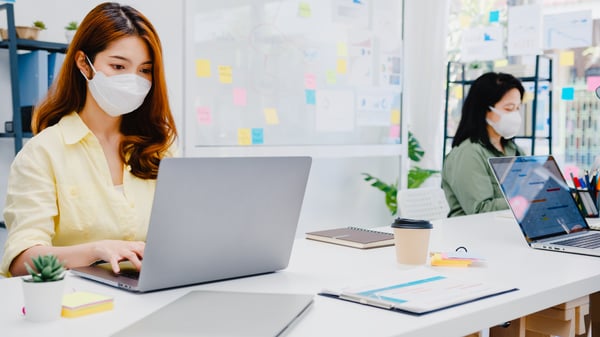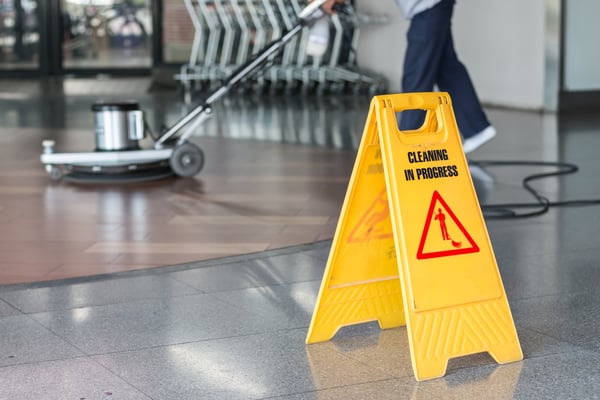Since the announcement of the easing of lockdown restrictions, many businesses across the UK have begun to make plans to return their workforce to their office spaces. Although restrictions are being relaxed, for many the threat of the Coronavirus still looms large.
This combination has created new requirements for employers to consider including what they need to do to allow staff to work safely in commercial offices during the Coronavirus Pandemic.
Following Government released guidelines, we have highlighted some key questions to ask yourself as an employer in order to create a safe office environment.
- Who should be in the office?
- How can I allow for social distancing?
- How do I manage customers, visitors and contractors entering my office?
- How do I clean my workplace?
- How do I manage my workforce?

1) Who should be in the office?
Although the lifting of lockdown restrictions allows for more people to return to commercial office spaces across the country, as an employer, you should be constantly evaluating who should be coming to the office.
Some employees may fall into the high-risk category making it dangerous for them to work in a highly populated space. Others may be showing symptoms of the Coronavirus and therefore should self-isolate at home. You should be open and flexible with staff members explaining the reasons why you want them to work in the office if needed.
Some important factors to consider when determining who should be in the office include:
- What is the maximum number of people who can be safely accommodated on site?
- Can you create a phased return to work for people to slowly return to the office?
- Can you monitor the wellbeing of people who are working on site both physically and mentally?
2) How can I allow for social distancing?
Social distancing is a recommended Government precaution to help minimise the chances of the virus being passed from person to person through close contact. When asking staff to return, it is important to work out how you can allow for social distancing best practices around the office.
Below are some tips on how to implement social distancing:
Create a staggered working day
A staggered working day across your workforce helps reduce busy periods during the morning and evening. By allowing a proportion of staff to work different hours, you reduce high traffic situations in communal areas across the office.
Create a one-way system
Staff moving around your office buildings is inevitable. Creating a one-way system helps manage the flow of people and reduces congestion and unnecessary contact.
Alter workstations
Where possible, try to keep workstations far apart. If you have a staggered workforce, you can even keep desks empty. You can also ask staff to remain at their workstations throughout the day, minimising time spent in communal areas where the chance of the Coronavirus spreading is higher.
Manage meetings
You can keep staff safe during a meeting by limiting the number of people allowed in a certain space. By keeping numbers down, you allow for social distancing best practices.
Manage common areas
Common areas, including canteens and break rooms, should be adjusted to allow for social distancing best practices. This can include closing certain tables and benches and asking staff to not linger.

3) How do I manage customers, visitors and contractors entering my office?
By nature, commercial office spaces will have multiple customers, visitors and contractors entering the premises daily. Unfortunately, these individuals are difficult to manage as an employer as they come and go so quickly. Below are some tips on how to create the safest environment for your staff:
- Encourage meetings through remote connection/video conferencing.
- Limit the number of visitors at any one time.
- Limit visitor times to a specific time window throughout the day.
- Schedule essential services and contractor visits in non-peak hours.
- Maintain a record of all visitors.
- Encourage visitors to use hand sanitiser or hand washing facilities as they enter the premises.
- Encourage visitors to practice social distancing and follow COVID-19 requirements set in place for the office.
4) How do I clean my workplace?
Commercial office spaces require constant cleaning and upkeep. These requirements have been intensified during the Coronavirus as the need for cleanliness has become essential. By constantly cleaning and disinfecting your workspace, you reduce the risk of the Coronavirus spreading from person to person through contact with surfaces. Below are some tips on how to clean your office:
- Deep clean your environment before returning using Electrostatic cleaning.
- Increase the frequency of your cleaning schedule.
- Dispose of waste properly.
- Promote personal hygiene.
- Use a professional cleaning service.
Check out our other blog for more information.

5) How do I manage my workforce?
As an employer, it is your responsibility to correctly manage your workforce. You can do this with simple adjustments to procedures, i.e. shift-patterns to create distinct groups and reduce the number of contacts each employee has. This will reduce and isolate the chance of the Coronavirus spreading. Your changes and adjustments should come as a response to mitigating as much risk away from your staff as you can.
Whatever you decide, it is vital that you create a clear and transparent COVID-19 policy available for your staff to see, ask questions about and ultimately follow. To do this, you should:
- Prove clear, consistent, and regular communication to improve understanding and consistency of ways of working.
- Engage with workers through existing communication routes and worker representatives to explain and agree any changes in working arrangements.
- Develop communication and training materials for workers returning to site, especially around new procedures at work.
